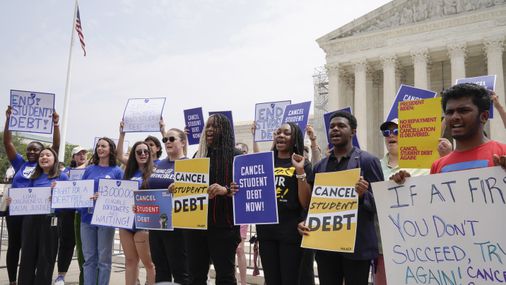“With the SAVE plan, we are making a promise to every student,” Education Secretary Miguel Cardona said during a call with reporters Monday afternoon. “Your payments will be affordable. You’re not going to be buried under a mountain of interest and you won’t be saddled with a lifetime of debt.”
The Biden administration’s new income-driven repayment plan known as SAVE opened for enrollment Tuesday, providing millions of borrowers with a more affordable way to pay their monthly student loan bills, which will become due again in October after a three-year pause.
Borrowers who are buckling under the pressure of their federal student loans have a new option to significantly cut their payments, eventually by as much as half.
Advertisement
In the coming days, more than 30 million borrowers will be invited to enroll in the new plan, initially proposed in January and which bases monthly payments on income and family size.
Unlike the White House’s former plan to cancel up to $20,000 in federal debt — struck down by the Supreme Court in June — this new payment option will become a permanent piece of the student loan machinery and be available to current and future borrowers. It also creates a new safety net, automatically enrolling certain borrowers into the SAVE plan after they have fallen behind on their payments.
Borrowers who want to sign up for the SAVE — or Saving on a Valuable Education — plan, should move quickly: You can expect to wait roughly four weeks for your application to be processed, senior department officials said. By enrolling now, your paperwork can be processed with enough time before your first payment becomes due, officials added.
Borrowers won’t receive the full benefits of the plan until next summer, because some features won’t immediately take effect. Here’s a rundown on how the plan will work:
Advertisement
Who is eligible for the new repayment plan?
Those with federal undergraduate or graduate loans. Borrowers with undergraduate debt are eligible for lower payments than graduate borrowers.
Who is excluded?
Parents who borrowed to pay for their children’s schooling using Parent PLUS loans cannot enroll in the new plan.
If parent borrowers cannot afford to make their payments, they generally have access to only the most expensive income-driven repayment plan — known as income-contingent repayment — which requires borrowers to pay 20% of their discretionary income for 25 years; anything remaining is forgiven.
How does the new SAVE plan work?
All income-driven repayment plans generally operate the same way. Payments are calculated based on your earnings and household size, and are readjusted each year. After monthly payments are made for a set number of years, usually 20, any remaining balance is forgiven. (The balance is taxable as income, although a temporary tax rule exempts balances forgiven through 2025 from federal income taxes.)
The SAVE plan — which replaced the existing Revised Pay As You Earn program, or REPAYE — is more generous in several ways. To start, it would reduce payments on undergraduate loans to 5% of discretionary income, down from 10% in the existing REPAYE plan (and 15% in other plans).
Graduate debt is also eligible, but borrowers would pay 10% of discretionary income on that portion. If you hold both undergraduate and graduate debt, your payment will be weighted accordingly.
The new rules also tweak the payment formula by protecting more income for basic needs, which in turn reduces payments overall. That change will also allow more low-income workers to qualify for $0 payments.
Advertisement
What is discretionary income?
Once you pay for basic needs like food and rent, any leftover income is considered discretionary; income-driven repayment plans require borrowers to pay a percentage of that discretionary income.
The SAVE plan tweaks the payment formula so that more income is shielded for those basic needs, generating less discretionary income and a lower payment.
SAVE increases the amount of income protected from repayment to 225% of the federal poverty guidelines, roughly equivalent to $15 an hour for a single borrower. If you earn less than that, you won’t have to make a monthly payment.
Put another way, a single person who makes less than $32,805 a year would make $0 monthly payments. The same goes for someone in a household of four with income below $67,500. That should help an additional 1 million low-income borrowers qualify for a zero-dollar payment, the Education Department said.
Under the old REPAYE program, less income was shielded, or up to 150% of the federal poverty guidelines.
Will the way interest is treated change?
Yes. This is one of the most attractive features of the new plan. If a borrower’s monthly payment does not cover the interest owed, the Education Department will cancel the uncovered portion.
In other words, if a borrower owes $50 in interest each month, but the payment covers only $30, the remaining $20 will disappear as long as the payment is made. And monthly interest will be canceled for those who are not required to make payments because their income is too low.
Advertisement
This new rule will provide relief to those who made payments but saw their balances balloon because they didn’t pay enough to cover the interest owed.
Does the plan go into effect right away?
Three big components of the plan are available now, including: shielding more of borrowers’ income from the repayment formula, which will reduce more borrowers’ payments to zero. The new treatment of unpaid interest is also in effect. Lastly, married borrowers who file their taxes separately will no longer be required to include their spouse’s income in their monthly payment calculation. (They will also have their spouse excluded from their family size.)
But other benefits — including cutting payments to 5% from 10% of discretionary income on undergraduate loans — won’t be implemented until July 2024.
Once the plan is in full swing next summer, many borrowers’ monthly bills, per dollar, will drop by 40% compared with the former REPAYE plan. But the lowest earners may see their payments fall by 83%, while the highest earners would receive only a 5% reduction.
Are there any changes for borrowers with small loan balances?
Yes, but this feature takes effect next summer.
People who took out smaller loans — or those with original balances of $12,000 or less — would make monthly payments for 10 years before cancellation, instead of the more typical 20-year repayment period in other income-driven repayment plans. Every additional $1,000 borrowed above the $12,000 amount would add one year of monthly payments before the balance is forgiven, up to a maximum of 20 or 25 years.
Advertisement
Will the new plan always be the best option?
The SAVE plan is expected to provide the lowest payment for most borrowers and will probably be the best option for most. The loan simulator tool at StudentAid.gov can help you analyze which repayment plan makes the most sense given your circumstances and goals.
When you sign in, it should automatically use your loans in its calculations. (You can add other federal loans if any are missing.) You can also compare plans side by side — how much they’ll cost over time, both monthly and in total, and if any debt would be forgiven.
How do I sign up?
You can sign up online at StudentAid.gov/SAVE; borrowers will be able to see their payment amount before signing up. Administration officials said the process shouldn’t take more than 10 minutes. After applying, you can check the status of your application by visiting your account dashboard.
Those who were already enrolled in the existing REPAYE plan don’t have to do anything — they will be automatically transferred into SAVE and their payment amounts will be adjusted.
Biden’s new student loan repayment plan is open. Here’s how to enroll.
RELATED ARTICLES




